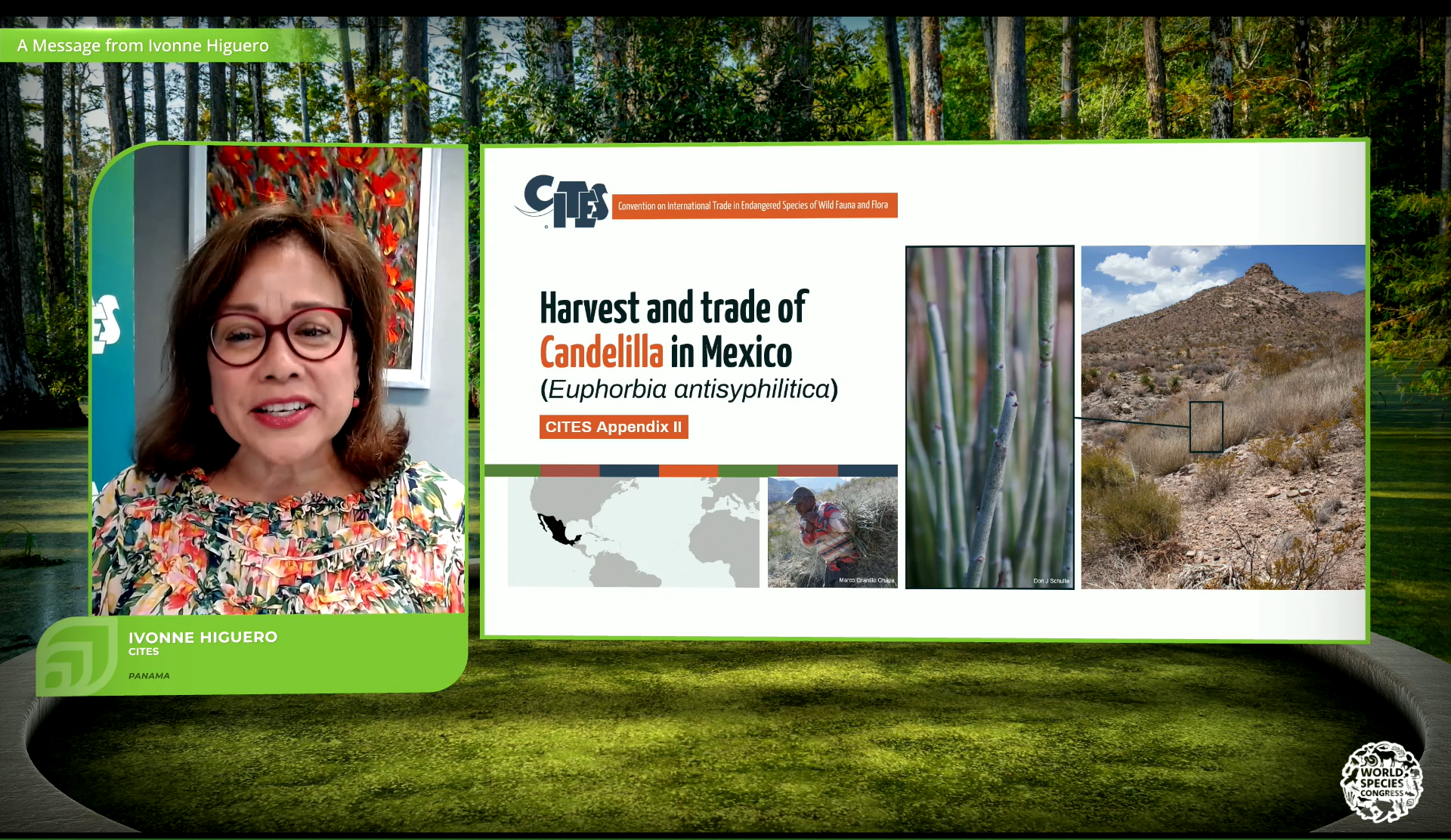World Species Congress 2024
Remarks by CITES Secretary-General Ivonne Higuero
15 May 2024
 Good day or good evening, to everyone online at this historic first World Species Congress! Congratulations to Reverse the Red.
Good day or good evening, to everyone online at this historic first World Species Congress! Congratulations to Reverse the Red.
It is a pleasure to join you in this celebration of successful strategies and exploration of new pathways for conservation. I am Ivonne Higuero, the Secretary-General of the Secretariat of the Convention on International Trade in Endangered Species of Wild Fauna and Flora or CITES. I am delighted to share with you how CITES has worked for the past 50 years to avoid species extinction by ensuring the sustainability, legality and traceability of international trade in wild animals and plants.
Global wildlife trade is an integral part of the world economy, with transactions involving individual species or derivative products valued in the millions or even billions of US dollars. Many sectors depend on wildlife, including construction, fashion, and the cosmetics industry.
Yet, we are facing severe challenges, from climate change to habitat loss to overexploitation. We must ensure that our use of wildlife resources is sustainable, not only for the survival of species in the wild, but also for the people who depend on them.
This is where CITES comes in.
Since the signing of the Convention in 1973, CITES has aimed to ensure that international trade in the more than 40,900 species currently listed in the Convention’s three Appendices is conducted sustainably, legally, and in a traceable manner.
This is achieved through key partnerships, a science-driven regulatory framework and enforcement mechanisms. CITES is legally binding for all 184 Parties to the Convention. Decisions about species listings and trade regulations are made by the highest body of the Convention, the Conference of the Parties, through a rigorous, science-based process.
Before CITES trade permits can be granted, CITES authorities must determine whether a specimen to be traded was legally acquired, according to the national legislation. We call this process a Legal Acquisition Finding or L-A-F.
Another requirement is a scientific assessment known as a Non-Detriment Finding or N-D-F, which is critical in determining whether international trade in a species will threaten its survival in the wild. If a Party to the Convention is found to be non-compliant with CITES rules, trade in a species or even in all CITES listed species for that country can be suspended.
By engaging with stakeholders along the entire value chain, CITES Management Authorities, Scientific Authorities and Enforcement Agencies work to strengthen the implementation of the Convention, prevent the overexploitation of vulnerable species, and ensure economic and environmental benefits for people in harmony with the customary sustainable use by indigenous peoples and local communities. This is where the CITES mission aligns most closely with the targets of the Global Biodiversity Framework.
In this slide, I will share one example of CITES’ role in species conservation, the case of the Candelilla succulent plant in Mexico.
I always like to highlight that it is a lesser-known fact that about 83% of all CITES-listed species are plants - Candelilla being one of them! We often focus on iconic mammals like elephants and rhinos but it is important to understand that there are many vulnerable species that have important functions in maintaining the health of our ecosystems and that also means our own health.
Now back to Candelilla: This succulent plant is harvested for its leaves to produce wax used in chewing gum, inks, cosmetics, and pharmaceutical products.
Candelilla harvest and trade provide local people with income and employment, while reinforcing traditional knowledge and cultural ties across generations. Without legal export opportunities for Candelilla wax, production would likely plummet, significantly affecting many families' livelihoods in the Chihuahuan Desert and potentially leading to displacement.
It was found that demand on the international market led to some unsustainable harvesting and trade without CITES permits, prompting CITES authorities in Mexico to improve harvesting methods that ensure adequate recovery time after extraction.
This also prompted measures for strengthening CITES implementation to avoid trade restrictions – including improving the process and guidance for making a non-detriment finding for Candelilla in accordance with the convention.
This is just one piece of the CITES regulatory framework that puts into action our mission to ensure the sustainability, legality and traceability of international wildlife trade.
If you are curious to learn more, I encourage you to check out the factsheets on CITES and livelihoods on our website (cites.org) and tune in to the livestream of our Animals and Plants Committee meetings in July where scientific experts will present their findings on the sustainability of trade in certain CITES-listed species.
I would like to thank the IUCN and Reverse the Red for inviting me today. The stories and strategies shared during these 24 hours reveal the vast potential for synergy and innovation. May the connections forged here propel us forward in conserving our magnificent biodiversity for generations to come.
Good luck with the rest of the programme!
__________________
Learn more about the World Species Congress 2024 here.